Although Provence is more famous as a spring and summer travel destination, Mr. TWS and I discovered that December is a wonderful time to visit this region in the south of France, especially to experience its Christmas traditions and festivities. The Christmas season in Provence begins on December 4th and officially ends on February 2nd each year.
Christmas traditions in Provence — religious and secular
In each city and village we visited, we enjoyed the religious, cultural, and creative displays and activities reflecting some of the key Christmas traditions of Provence. Most of the people with whom we spoke still observe old traditions while also incorporating modern ones, such as decorated Christmas trees and Santa Claus.
And so the season begins
The festivities begin on December 4th, the Feast of Saint Barbara, when people plant wheat or lentil seeds. Dishes of fresh green sprouts are traditional adornments for the Christmas Eve dinner table and were displayed in many places we visited. The legend says that if the seeds sprout, the harvest will be good. How high the wheat has grown by December 25th foretells just how prosperous a new year one can expect.
The 13 Desserts
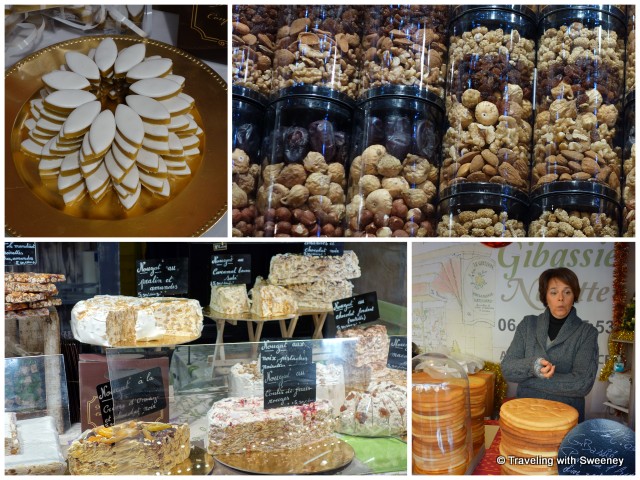
A sampling of the 13 Desserts — Clockwise from top left: Calissons d’Aix, fruits and nuts, pompe a l’huile (sweet bread made with olive oil), and nougat
The 13 Desserts is certainly the sweetest of the Provençal Christmas traditions. It is a selection of crystallized fruit and other special sweets served in homes after Midnight Mass on Christmas Eve. The desserts include four base items representing Catholic religious orders that took vows of poverty: walnuts and hazelnuts for the Augustinians, dried figs for the Franciscans, raisins for the Dominicans, and almonds for the Carmelites. The other desserts vary throughout Provence (with selections emphasizing a village’s local products), but commonly include a combination of treats. See our 13 Desserts post for a list of these and more photos.
Nativity scenes and santons
As in many cultures, nativity scenes (crèches) featuring the Baby Jesus, the Virgin Mary, Joseph, and other biblical figures are prominently displayed in churches and other locations in the communities. In Provence, there are also other secular figures (santons, the “little saints”) that are key characters alongside them.
Santons are distinctive hand-crafted clay figurines originally created for nativity scene representations, but expanded to include figures that illustrate local life in Provence in the 19th century. The art and craft of santons is a culturally important tradition passed down through generations. Our previous article about santons has more detail and photos.
The crèche in l’Eglise des Celestins on Place des Corps Saints in Avignon (shown above) showcased santons created by renowned santonnier Marcel Carbonel and included over 600 santons in a Provençal landscape, with vineyards, olive groves and hilltop villages.
The photo above captures a section of a crèche created by Henri Angiolini installed at the Musée Grévin in Salon-de-Provence. The entire crèche took Mr. Angiolini over 2,000 hours to make.
A large crèche in the Carpentras tourism office attracts visitors from all over the region and beyond. Each year the display has different themes and those for 2014 were wine, wine-making, and wood trades. It was an amazing display detailing scenes in forest and hillside settings.
Christmas markets, plays, and fairs
Christmas markets in Provence are relatively new (about 15 years). Differing from ones we have seen in other parts of Europe, they are smaller and focus on the local products and crafts of each area. And there’s plenty of food, drink, crafts, and activities. Hot wine, sausages, cheese, candy, pastries and other local delicacies are served. During this 2014 trip, we visited Christmas markets in Avignon, Salon-de-Provence, Aix-en-Provence, and Cassis.
Christmas markets in Avignon cover several town squares, including the Place de l’Horloge which has chalets with crafts, decorations, textiles, jewelry, figurines, nougats, chocolate, and wine. I’ve tasted my share of hot wine (“vin chaud” in France) at European Christmas markets, but it was a nice change of pace to have champagne as an option while strolling the chalet booths in Avignon.
In a lovely setting near the port in the old town section of the seaside village of Cassis, we relaxed with hot wine at a small and beautiful Christmas market (shown above) and took in the scene as craft chalets opened for business and the delicious aroma of grilling sausages began to waft through the market.
Many of the markets had entertainment for children such as plays, balloon artists, storytellers, carousels, ice skating, and visits from Santa Claus.
Fairs, street performances, story-telling events, pastoral plays, traditional dancing and music draw crowds to cities such as Arles for the Drôles de Noëls (with circus performers, singers, puppeteers, magicians, theatre and firework displays). In Aix-en-Provence, Bravade Calendale, an annual event in which more than 250 participants dress in costume for a parade and festivities, draws thousands of spectators.
Symbolism and traditions on Christmas Eve
Religious symbolism is mixed with folklore rituals in many Provençal traditions. One Christmas Eve ritual involves the oldest family member taking a lit candle and walking backward with it toward the rest of the family. According to tradition, if the flame is flat, the harvest will be good. If it is upright, the crops will fail.
Another ritual, Cacho-Fio, involves lighting a Yule log. Both the oldest and youngest family members pour mulled wine over the log three times and place it in the fireplace. As they recite a chant of joy and thankfulness to God, they light the log. Typically, there is also a request for the new year that concludes with the line (loosely translated): “Let us have no less if we are to have no more.”
The special Christmas Eve dinner is called Le Gros Souper (“the grand supper”). The table is set with three white tablecloths and three candles both representing the Holy Trinity. On the table and eaten with the meal are 13 loaves of bread that symbolize the Last Supper. One large loaf represents Jesus, and the 12 smaller loaves represent the 12 apostles. The meal includes seven dishes to symbolize the seven wounds of Christ (we also heard an interpretation that said the dishes symbolized the seven sorrows of the Virgin Mary). The dishes vary within Provence according to local traditions which favor local products. Near the sea, fresh fish dishes are usual; further inland, meals are vegetable-based, and in the mountains a common dish is made of a local pasta. In keeping with Christmas as the season of charity, a place is also symbolically set for a stranger in need, known as “the poor man’s seat”.
And the season ends
The season officially ends on Candlemas (The Feast of the Purification) on February 2nd with festivities after Mass which include eating navettes (pictured below). These biscuits represent the row boat in which it is believed that Mary Magdelene arrived in Provence from Israel in 40 AD. This is also the day that nativity scenes are taken down and the treasured santons are carefully stored for the following year.
Discovering Provence’s unique Christmas traditions gave us a real jump start to our holiday spirit.
PIN it for later!

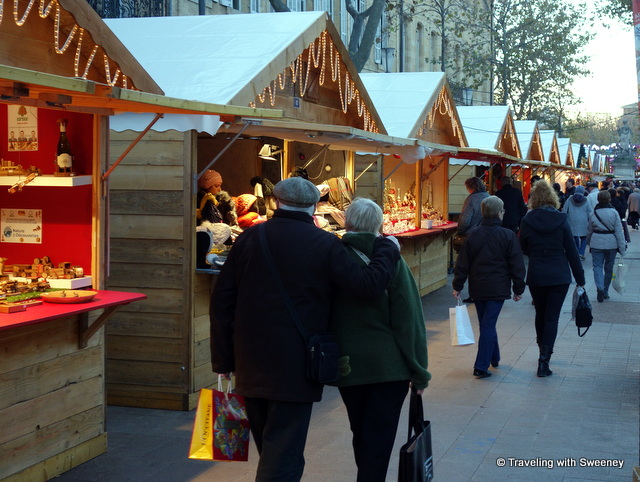
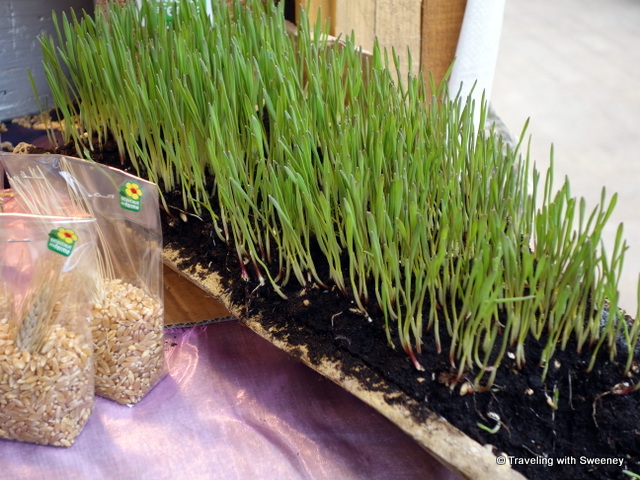
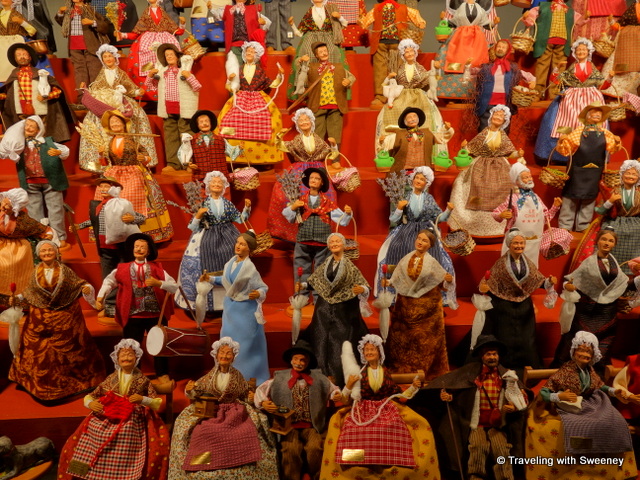
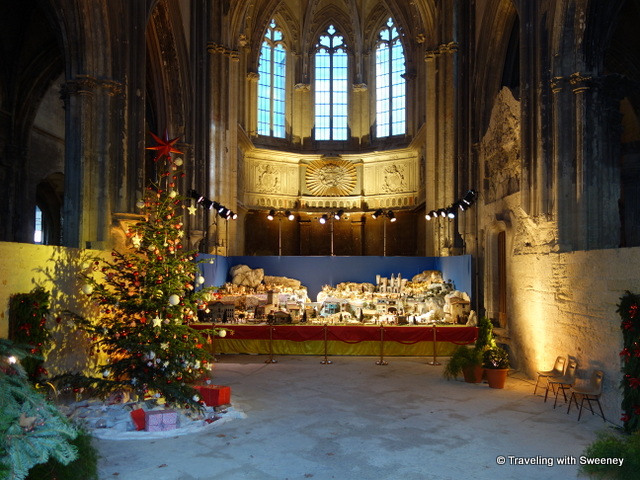
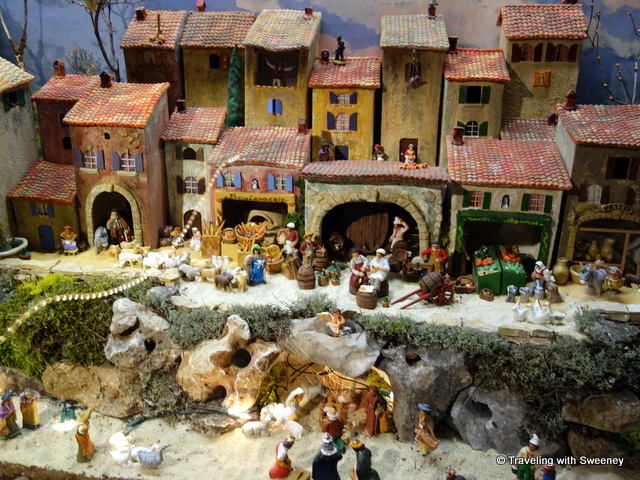

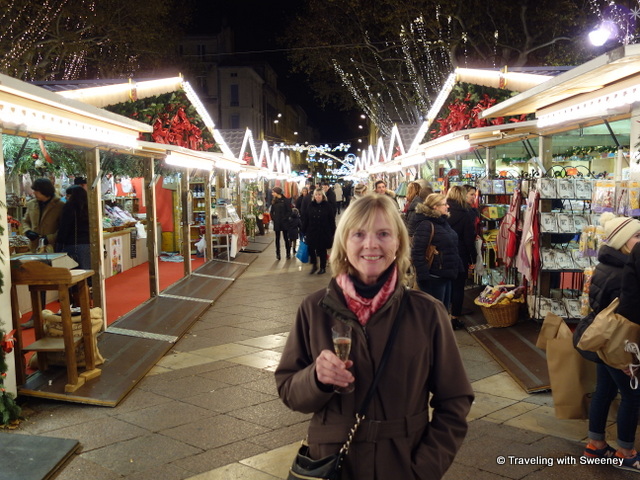

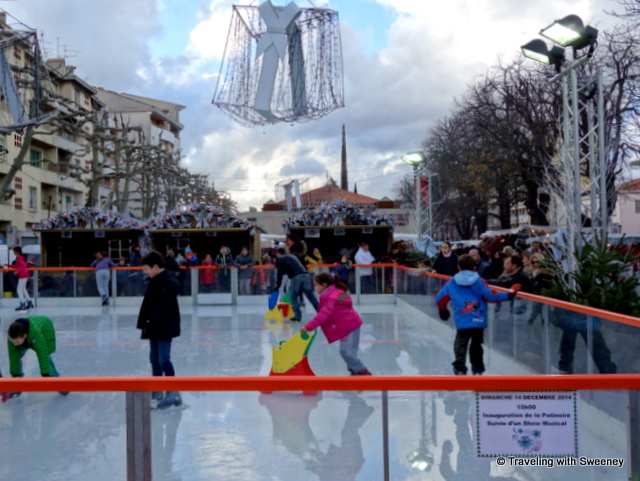

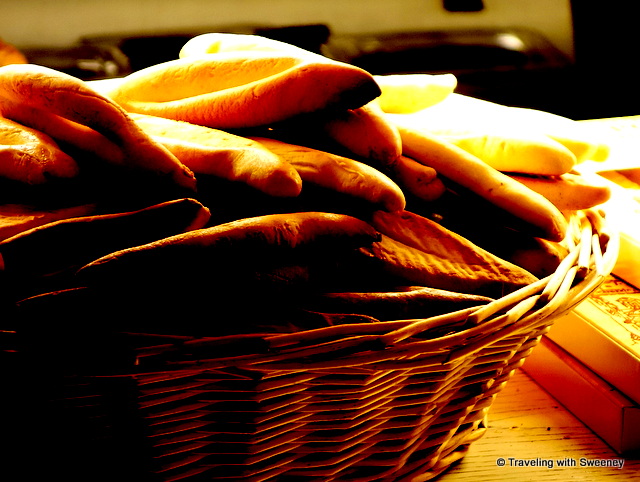
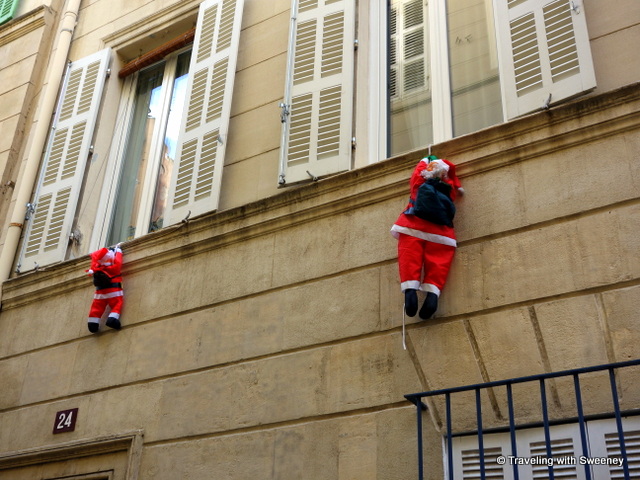
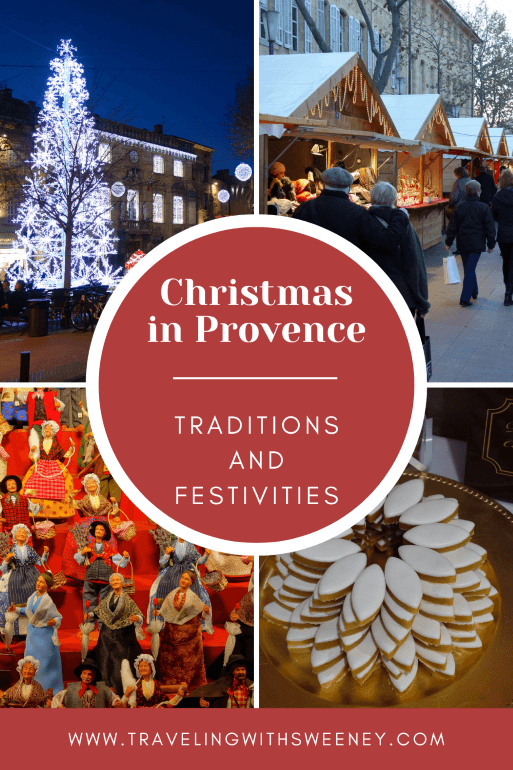
Pingback: Christmas Traditions in Provence: 13 Desserts - Traveling with Sweeney
I started thinking Dec 4th was early then I remembered that Christmas has already started here. Stores and offices are decorated and even though it’s been in the 60s here the last two days, Christmas markets and Christmas tree vendors have already set up.
I’m surprised Christmas markets are so new to Provence. I’d go for the food, the pastries and the hot wine – or maybe some champagne.
Love the Santas climbing up the wall…
I’ll be around here for Christmas but haven’t made firm plans. Where will you be kicking off your Christmas, Cathy?
Mr. TWS and I have Portugal coming up next — a river cruise on the Douro with Viking River Cruises. It’ll be interesting to learn about Portuguese Christmas traditions while we’re there.
Pingback: Christmas Traditions in Provence: The Little Saints - Traveling with Sweeney
I’m not a big Christmas person, but living in Europe – where the commercialism doesn’t happen until after the season – is changing my tune! I especially love the markets!
Wow, this is a megapost, and I’ve re-read it a couple of times. I think the Christmas Season in Provence is sometime I need to experience for myself.
I *have* to visit a European Christmas market – i think THIS will be the one! Amazing!
Hi Cathy! I love all of these local traditions. Provence looks like a perfect place to to enjoy the holidays. I had no idea that celebrations go on until February 2nd. I land in Barcelona on December 25th, and looking forward to exploring a Christmas market! Thanks for linking up this week. #TPThursday
Love this ! It’s putting me in the mood to sing carols and dream of 13 desserts!
LOVE this post, it captures what is so festive and unique about Christmas in Provence. I’ve written about all these things too and even have exactly the same photo of wheat taken in Aix market last year! So much the same that I did a double take and thought you’d got my photo and then I realised I’d never published it anywhere so it couldn’t be possible! (And obviously it goes without saying that you wouldn’t do that, but really it is exactly the same, with the same light and everything! I went to the Christmas market in Aix on Sunday 7 Dec last year, maybe we were there on the same day – or maybe you’re going to say you took yours somewhere else!!!) We obviously have the same eye and enjoy the same things. Thanks for linking up to #AllAboutFrance again, good to see you back.
Funny about the wheat photo, Phoebe. We both must have good eyes for photos. 🙂
Thanks for writing about all the traditions there, I didn’t know many of them. Christmas certainly seems to be a big affair in Provence than other parts of France. Have a good one yourself. #allaboutfrance
Great post! nice photos! # allaboutfrance11
I learned so much from your post! Thank you for explaining the various traditions more in-depth. Those nativity scenes are super intense and beautiful, great photos! Another great post on #AllAboutFrance!
Great post. I enjoyed learning about the traditional Christmas customs such as the wheat grass and yule log. Traditions that give thanks and appreciation are my favorite.
Hah! That last photo of the dangling Santas is so fun!
I loved learning about some of the Christmas traditions of Provence! And how fun to stroll a Christmas market with champagne in hand! Only in France 🙂 #AllAboutFrance
Pingback: Cassis France: A Village By the Sea in Provence
Pingback: Giving Thanks in 10 Languages
Pingback: Arles, France: City of the Romans | Traveling with Sweeney
Pingback: Giving Thanks for Travel in 11 Languages | Traveling with Sweeney
Pingback: Giving Thanks in 16 Different Languages | Traveling with Sweeney
Pingback: Christmas in Europe: Dazzling Markets and Rich Traditions | Traveling with Sweeney
Pingback: Our Christmas Greetings from Paris - Traveling with Sweeney